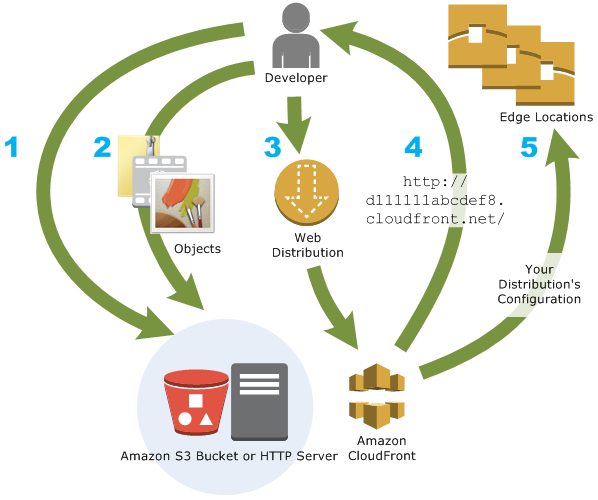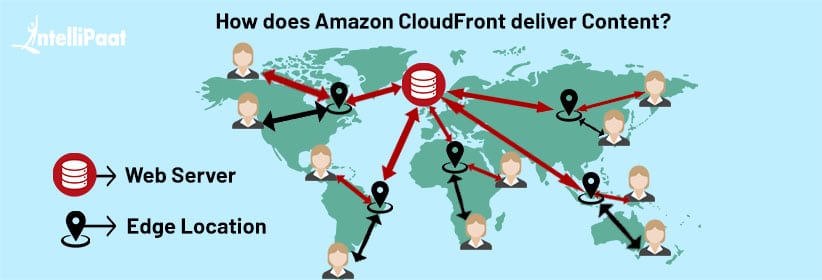Amazon CloudFront’s Role in AWS’s Comprehensive Cloud Offerings

Amazon CloudFront is a global content delivery network (CDN) that forms an integral part of Amazon Web Services’ (AWS) comprehensive cloud offerings. It enables developers and businesses to deliver content securely, efficiently, and reliably to end users worldwide with low latency and high bandwidth.

Key Features and Benefits of Amazon CloudFront:

- Global Presence: A vast network of edge locations around the world, caching content closer to end users for faster delivery.
- Low Latency: Reduces the time it takes for content to reach users, improving page load speeds and overall user experience.
- High Bandwidth: Supports massive amounts of traffic, ensuring content is delivered seamlessly and without interruptions.
- Secure Delivery: Uses SSL encryption to protect data in transit and supports secure protocols like HTTPS and TLS.
- Scalability: Automatically adjusts to traffic demands, ensuring content is delivered smoothly even during peak usage periods.
- Cost-Effective: Pay-as-you-go pricing based on usage, making it an affordable solution for businesses of all sizes.
Integration with Other AWS Services:
CloudFront seamlessly integrates with other AWS services to enhance its functionality and automate content delivery workflows:
- Amazon S3: Stores and manages content, providing a reliable and secure source for CloudFront distribution.
- Elastic Load Balancing: Distributes incoming traffic across multiple servers, ensuring high availability and performance.
- Route 53: Provides domain name services and manages DNS records for CloudFront distributions.
- AWS WAF: Integrates with CloudFront to protect web applications from malicious attacks and vulnerabilities.
Use Cases for Amazon CloudFront:
CloudFront is widely used for various applications, including:
- Web and mobile app content delivery: Faster loading of websites, apps, and other web content.
- Video streaming: Seamless delivery of live and on-demand video to global audiences with minimal buffering.
- Software updates: Efficient distribution of software updates and patches to a wide user base.
- Large file downloads: Fast and reliable delivery of documents, images, and other large files.
- E-commerce content: Improved user experience for e-commerce platforms by delivering product images, videos, and descriptions quickly.
Conclusion:
Amazon CloudFront is a cornerstone of AWS’s comprehensive cloud offerings, providing a robust and scalable content delivery network. Its global presence, low latency, high bandwidth, secure delivery, and easy integration with other AWS services make it an essential tool for businesses looking to deliver content reliably and efficiently to their users worldwide.## Amazon Cloudfront’s Role In AWS’s Comprehensive Cloud Offerings
Executive Summary
Amazon Cloudfront is a content delivery network (CDN) that is part of Amazon Web Services (AWS). It is designed to deliver content to end users with low latency and high throughput. Cloudfront can be used to deliver a variety of content, including static web pages, images, videos, and software downloads.
Cloudfront is integrated with other AWS services, such as Amazon S3 and Amazon EC2. This integration makes it easy to create and manage a content delivery network that is tailored to your specific needs.
Introduction
Amazon Cloudfront is a global CDN that provides fast and reliable content delivery. It is designed to help businesses improve the performance of their websites and applications by reducing latency and improving throughput.
Cloudfront is a key part of AWS’s comprehensive cloud offerings. It can be used in conjunction with other AWS services, such as Amazon S3 and Amazon EC2, to create a complete content delivery solution.
FAQ
1. What is Amazon Cloudfront?
Amazon Cloudfront is a global CDN that provides fast and reliable content delivery. It is designed to help businesses improve the performance of their websites and applications by reducing latency and improving throughput.
2. How does Amazon Cloudfront work?
Cloudfront works by caching content on servers around the world. When a user requests content from your website or application, Cloudfront will deliver the content from the nearest server, reducing latency and improving throughput.
3. What are the benefits of using Amazon Cloudfront?
There are many benefits to using Amazon Cloudfront, including:
- Improved website and application performance: Cloudfront can help to improve the performance of your website or application by reducing latency and improving throughput.
- Reduced costs: Cloudfront can help you to reduce costs by reducing the amount of bandwidth that you use.
- Increased security: Cloudfront can help to protect your website or application from DDoS attacks and other security threats.
Subtopics
1. Performance
Cloudfront is designed to deliver content with low latency and high throughput. This makes it ideal for delivering content to end users who are located around the world.
- Edge locations: Cloudfront has edge locations in over 200 cities around the world. This means that content can be delivered to end users with low latency.
- High throughput: Cloudfront can deliver content at high throughput. This means that end users can download content quickly and easily.
- Optimized for mobile: Cloudfront is optimized for mobile delivery. This means that end users can access content on their mobile devices quickly and easily.
2. Security
Cloudfront is designed to protect content from DDoS attacks and other security threats.
- DDoS protection: Cloudfront can protect content from DDoS attacks by using a variety of techniques, such as rate limiting and blacklisting.
- SSL/TLS encryption: Cloudfront can encrypt content using SSL/TLS encryption. This helps to protect content from eavesdropping and tampering.
- Access control: Cloudfront can use access control to restrict who can access content. This helps to protect content from unauthorized access.
3. Cost
Cloudfront is a cost-effective way to deliver content.
- Pay-as-you-go pricing: Cloudfront uses a pay-as-you-go pricing model. This means that you only pay for the resources that you use.
- No upfront costs: There are no upfront costs to use Cloudfront. This makes it a good option for businesses that are on a budget.
- Discounts for volume: Cloudfront offers discounts for volume. This means that you can save money by delivering more content through Cloudfront.
4. Integration
Cloudfront is integrated with other AWS services, such as Amazon S3 and Amazon EC2. This integration makes it easy to create and manage a content delivery network that is tailored to your specific needs.
- Amazon S3: Cloudfront can be used to deliver content that is stored in Amazon S3. This makes it easy to create a static website or host a large media library.
- Amazon EC2: Cloudfront can be used to deliver content that is hosted on Amazon EC2. This makes it easy to create a dynamic website or host a web application.
5. Features
Cloudfront offers a variety of features that can help you to improve the performance and security of your website or application.
- Customizable caching: Cloudfront allows you to customize how content is cached. This gives you control over how your content is delivered to end users.
- Real-time monitoring: Cloudfront provides real-time monitoring of your content delivery network. This allows you to track the performance of your network and identify any potential problems.
- Support: Cloudfront is supported by AWS’s world-class customer support team. This means that you can get help with any issues that you may encounter.
Conclusion
Amazon Cloudfront is a global CDN that provides fast and reliable content delivery. It is designed to help businesses improve the performance of their websites and applications by reducing latency and improving throughput.
Cloudfront is a key part of AWS’s comprehensive cloud offerings. It can be used in conjunction with other AWS services, such as Amazon S3 and Amazon EC2, to create a complete content delivery solution.
If you are looking for a way to improve the performance of your website or application, then Amazon Cloudfront is a great option. It is a cost-effective, reliable, and secure way to deliver content to end users around the world.
Keyword Tags
- Amazon Cloudfront
- CDN
- Content delivery
- AWS
- Cloud computing
